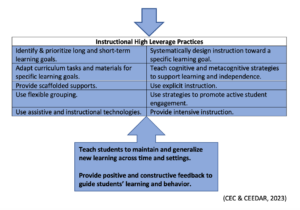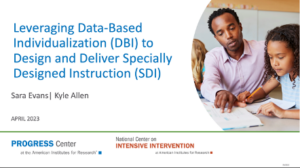Educator’s Article:
Specially Designed Instruction: The Old and the Beautiful
Administrator’s Corner

During the 2023-2024 school year, Link Lines articles will be focused on Specially Designed Instruction (SDI) that targets specific academic, behavioral, and functional skill progress. While school leaders supervising special education are responsible for technical compliance during the eligibility process and Individualized Education Program (IEP) development, the practical impact of those efforts should result in data-driven SDI. The IEP goals should drive SDI, but day to day SDI is not always mapped out in the four corners of the document. The IEP outlines long-term goals and services, but the day to day instruction provided to students evolves in response to frequent progress monitoring. Inclusive school leaders make sure that weekly intervention plans are designed, delivered, monitored, and adjusted based on student response data.
The current Link Lines educators’ lesson, “Specially Designed Instruction: The Old and the Beautiful,” provides teachers with a detailed overview of SDI including tips, tools, and resources for development. Included among those resources is an observation tool for SDI that administrators can use to facilitate and monitor intervention practices. Facilitating and monitoring effective SDI provides inclusive school leaders with the opportunity to take a collaborative coaching stance with special education teachers. When everyone serving students with disabilities approaches SDI with a combination of curiosity and application of the scientific method to teaching and learning, amazing things happen.
Administrators can set the stage for success by working with special education teachers to implement the High Leverage Practices (HLPs) developed by the Council for Exceptional Children (CEC) and the Collaboration for Effective Educator Development, Accountability and Reform (CEEDAR) Center. These HLPs offer resources designed to help educators implement effective practices focused on collaboration, assessment, social/emotional/behavioral needs, and instruction (CEC & CEEDAR, 2023). A good starting point for developing teacher skills with the HLPs is assessment literacy. Special education teachers who are confident in navigating existing assessment results and choosing additional assessments to identify students’ strengths and needs will be better positioned to effectively target skills and develop effective SDI. Figure 1 depicts the relationship between the assessment HLPs and the instructional HLPs.
Figure 1
Assessment and Instructional High Leverage Practices


Special education teachers who become proficient with assessment selection and interpretation will be able to develop SDI that targets individual student needs and accomplishes access to, and progress in, the general education curriculum. Once teachers are confident and proficient with assessment literacy and the development of SDI, school leaders can provide professional development and coaching focused on what to do when students don’t respond to initial interventions. For students who require more intensive interventions, the Data-Based Individualization (DBI) problem-solving process helps teachers apply the scientific method to teaching and learning (National Center on Intensive Intervention [NCII], 2018).
The DBI problem solving process starts with the implementation of a validated intervention program and progress monitoring for student response to that intervention (NCII, 2018). If a student responds to the intervention and is making adequate progress, the intervention is continued and monitored. If a student does not respond to the intervention or does not make adequate progress, a data-based hypothesis is formed about the reason for the limited response. That hypothesis is then used to adapt the intervention and then monitor for improved response. This process of intervention, progress monitoring, diagnosing, and adapting continues until the student makes sufficient progress and closes specific skill gaps. The DBI approach to intensifying interventions increases the likelihood that students will be able to accelerate their rate of skill acquisition and make progress toward grade level expectations. The momentum created by ongoing individualized interventions is rewarding for both students and teachers.
Inclusive school leaders supporting special education teachers can build knowledge and skills by helping teachers navigate the alphabet soup of special education related abbreviations (e.g., IEP, SDI, HLP, DBI). It is important to talk about the practical applications of these elements of special education and make them manageable for teachers. The frameworks and tools available from the resources below can help school leaders and teachers make sense of the landscape and, ultimately, improve outcomes for students with disabilities. Teachers who experience supervision and coaching designed to make their jobs manageable and rewarding are more likely to stay in the profession and can bring important experience to the classroom for years to come.
Resources
VDOE Special Education Modules
Click the image to access VDOE developed modules.
High Leverage Practices Webinar
Click the image to access the recorded webinar.
PROGRESS Center & National Center on Intensive Intervention Webinar
Click the image to access the recorded webinar.
References
Council for Exceptional Children & Collaboration for Effective Educator Development, Accountability and Reform Center. (2023). High-leverage practices: Fundamental to effective teaching. https://highleveragepractices.org/
National Center on Intensive Intervention. (2018). Breaking down the DBI process: Questions & considerations. Office of Special Education Programs. U.S. Department of Education. https://intensiveintervention.org/sites/default/files/NCII-placemat-508.pdf







